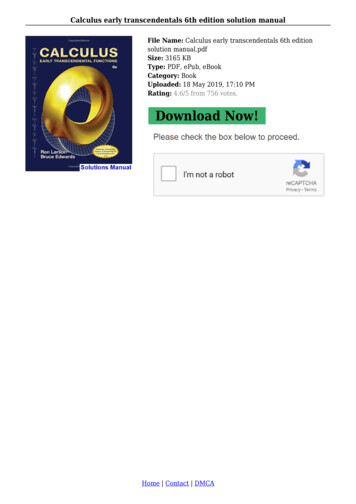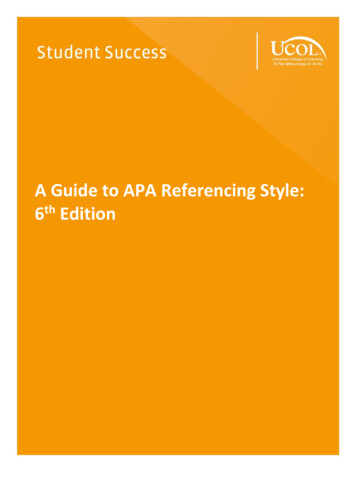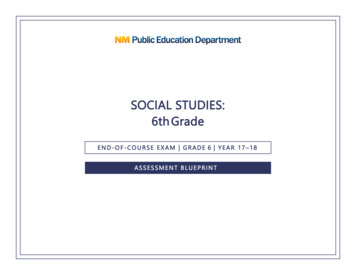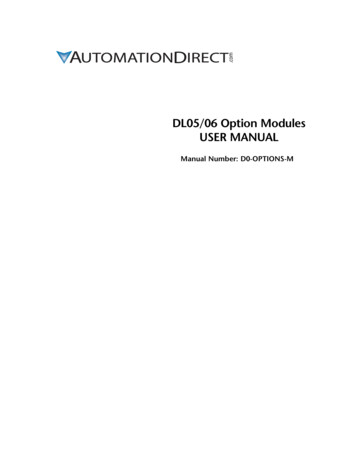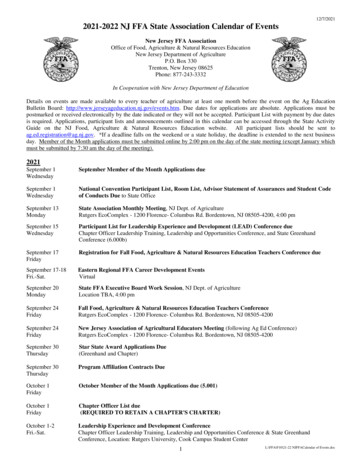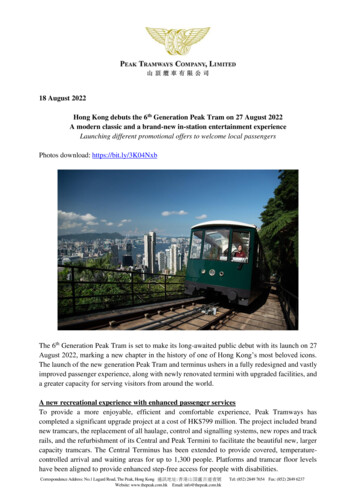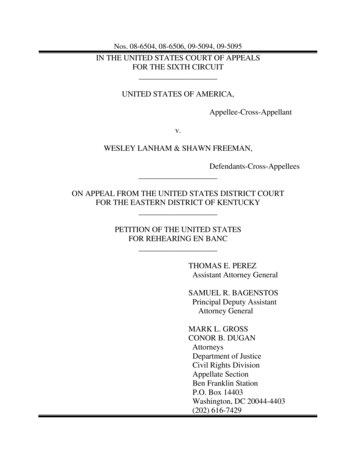
Transcription
Nos. 08-6504, 08-6506, 09-5094, 09-5095IN THE UNITED STATES COURT OF APPEALSFOR THE SIXTH CIRCUITUNITED STATES OF AMERICA,Appellee-Cross-Appellantv.WESLEY LANHAM & SHAWN FREEMAN,Defendants-Cross-AppelleesON APPEAL FROM THE UNITED STATES DISTRICT COURTFOR THE EASTERN DISTRICT OF KENTUCKYPETITION OF THE UNITED STATESFOR REHEARING EN BANCTHOMAS E. PEREZAssistant Attorney GeneralSAMUEL R. BAGENSTOSPrincipal Deputy AssistantAttorney GeneralMARK L. GROSSCONOR B. DUGANAttorneysDepartment of JusticeCivil Rights DivisionAppellate SectionBen Franklin StationP.O. Box 14403Washington, DC 20044-4403(202) 616-7429
TABLE OF CONTENTSPAGEINTRODUCTION .1BACKGROUND .3ARGUMENTTHE PANEL DECISION DISREGARDS PRECEDENTCLEARLY ESTABLISHING THAT THE SENTENCINGGUIDELINES ARE MERELY ADVISORY AND THEREFOREDO NOT IMPLICATE THE EX POST FACTO CLAUSE .6CONCLUSION.14CERTIFICATE OF SERVICE
TABLE OF AUTHORITIESCASES:PAGECalder v. Bull, 3 Dall. 386 (1798) .11California Dep’t of Corrections v. Morales, 514 U.S. 499 (1995) .9, 11Collins v. Youngblood, 497 U.S. 37 (1990).11Gall v. United States, 552 U.S. 38 (2007) . 8-9Johnson v. United States, 529 U.S. 694 (2000).11Kimbrough v. United States, 552 U.S. 85 (2007).7Miller v. Florida, 482 U.S. 423 (1987) .11Rita v. United States, 551 U.S. 338 (2007).2, 8, 10United States v. Booker, 543 U.S. 220 (2005).2, 7, 10United States v. Cook, 453 F.3d 775 (6th Cir. 2006) .7United States v. Demaree, 459 F.3d 791 (7th Cir. 2006),cert. denied, 551 U.S. 1167 (2007).2, 5, 8, 12United States v. Lewis, 606 F.3d 193 (4th Cir. 2010) .5, 12United States v. Nurek, 578 F.3d 618 (7th Cir. 2009),cert. denied, 130 S. Ct. 2093 (2010).2, 5, 12United States v. Turner, 548 F.3d 1094 (D.C. Cir. 2008) .5, 12STATUTES:18 U.S.C. 2.418 U.S.C. 241.4-ii
STATUTES (continued):PAGE18 U.S.C. 242.418 U.S.C. 1519.418 U.S.C. 3553.618 U.S.C. 3553(a)(4)(A)(ii) .passim18 U.S.C. 3742(g) .6RULES:Fed. R. App. P. 35, Advisory Committee Notes (1998 Amendments) .12Fed. R. App. P. 35(a)(2).2Fed. R. App. P. 35(b)(1)(A).2Fed. R. App. P. 35(b)(1)(B) .2-iii
IN THE UNITED STATES COURT OF APPEALSFOR THE SIXTH CIRCUITNos. 08-6504, 08-6506, 09-5094, 09-5095UNITED STATES OF AMERICA,Appellee-Cross-Appellantv.WESLEY LANHAM & SHAWN FREEMAN,Appellants-Cross-AppelleesON APPEAL FROM THE UNITED STATES DISTRICT COURTFOR THE EASTERN DISTRICT OF KENTUCKYPETITION OF THE UNITED STATESFOR REHEARING EN BANCINTRODUCTIONThe United States hereby petitions for rehearing en banc of the August 24,2010, panel decision in United States v. Lanham, to address that portion of thedecision which held that Ex Post Facto concerns prevented application of currentSentencing Guidelines. Slip op. 19-20. En banc consideration is appropriate for anumber of reasons.First, the panel opinion effectively holds 18 U.S.C. 3553(a)(4)(A)(ii), whichdirects courts to apply the Sentencing Guidelines in “effect on the date the
-2 defendant is sentenced,” unconstitutional in those cases where the time-of sentencing Guidelines reflect a higher sentence than the time-of-offenseGuidelines. Invalidation of a congressional enactment obviously reflects aquestion of “exceptional importance.” See Fed. R. App. P. 35(a)(2).Second, in rejecting the government’s argument that the use of post-offense,severity-enhancing Guidelines does not violate the Ex Post Facto Clause, the panelopinion conflicts with the Supreme Court’s repeated holdings that the Guidelinesare “general advice” that a district court “filter[s]” through “§ 3553(a)’s list offactors.” Rita v. United States, 551 U.S. 338, 358 (2007); see also United States v.Booker, 543 U.S. 220, 245-246 (2005) (sentencing judge is “permit[ted]” to “tailorthe sentence in light of other statutory concerns”). Rehearing en banc isappropriate when a panel decision conflicts with decisions of the Supreme Court.Fed. R. App. P. 35(b)(1)(A).Third, the panel opinion merits en banc consideration because it conflictswith “authoritative decisions” from the United States Court of Appeals for theSeventh Circuit. Fed. R. App. P. 35(b)(1)(B); see United States v. Nurek, 578 F.3d618 (7th Cir. 2009), cert. denied, 130 S. Ct. 2093 (2010); United States v.Demaree, 459 F.3d 791 (7th Cir. 2006), cert. denied, 551 U.S. 1167 (2007).Finally, the panel opinion unnecessarily complicates sentencing. Instead ofsimply taking the Guidelines in effect at sentencing, a district court must determine
-3 whether there have been any changes in the Guidelines since the time of theoffense that could lead to a more onerous Guidelines range.BACKGROUND1. This case arises from an incident that occurred in the early morning ofFebruary 14, 2003, at the Grant County Detention Center in Williamstown,Kentucky. R. 91, Tr., p. 47 (Sydnor). 1 Eighteen-year-old Joshua Sester had beenarrested for a traffic violation that night and brought to the Detention Center. R.91, Tr., pp. 49-51 (Sydnor). Wesley Lanham, Shawn Freeman, Clinton “Shawn”Sydnor, and Jack Powell were corrections officers at the Detention Center. R. 91,Tr., p. 47 (Sydnor). Sydnor, Lanham, and Freeman all agreed to place Sester in thegeneral prisoner population at the Detention Center, instead of the holding celldictated by jail policy, in order to “scare[]” him. R. 91, Tr., pp. 30-31, 55, 62(Sydnor). After being left in the general prisoner population cell, some of theinmates beat and raped Sester. R. 86, Tr., pp. 39-44 (Sester), 82 (Wright). Sesterremained in the cell all night, during which time none of the officers checked onhim. R. 92, Tr., p. 8 (Sydnor). The next night, after learning of the assaults and1“R.” refers to the district court record. The first number after “R.” is thedocument number in the district court number. “Tr.” refers to the trial transcript.“S.Tr.” refers to the sentencing transcript. “GX” refers to the government’s trialexhibits. “Apx.” refers to the appendix.
-4 rape, the officers filed false official reports. R. 81, GX 4-6, Apx. 30-32; R. 86, Tr.,p. 127 (Powell).2. A grand jury returned a seven-count indictment against Sydnor, Freeman,and Lanham. R. 1, Indictment. Sydnor pleaded guilty and testified for thegovernment. The indictment charged Lanham and Freeman each with: (1)conspiring under color of law to violate Sester’s constitutional rights in violation of18 U.S.C. 241; (2) aiding and abetting each other, under color of law, in thedeprivation of Sester’s constitutional rights in violation of 18 U.S.C. 242 and 18U.S.C. 2; and (3) falsifying records to obstruct justice in violation of 18 U.S.C.1519. R. 1, Indictment, pp. 2, 5, 6a-6b, 7.2 On August 14, 2008, a jury foundLanham and Freeman guilty on all counts. R. 78-79, Verdict Forms.3. The Probation Office’s Presentence Investigation Reports (PSR) relied onthe 2002 Sentencing Guidelines. Lanham’s PSR yielded a guideline sentencingrange of 262 to 327 months. R. 135, PSR, ¶¶ 40, 69. Freeman’s PSR yielded aguideline sentencing range of 210 to 262 months. R. 137, PSR, ¶¶ 40, 71. TheUnited States objected to the Presentence Report, arguing that the current, moresevere 2008 Sentencing Guidelines applied, and that the application of the 2008Guidelines would not violate the Ex Post Facto Clause.2The indictment is mispaginated with an unpaginated page appearingbetween 6 and 7. It is described as 6b and page 6 as 6a.
-5 The sentencing hearing was held on December 8, 2008, and the courtdeclined to apply the 2008 Guidelines. R. 143, Lanham S.Tr., p. 12; R. 142,Freeman S.Tr., p. 7.4. The government appealed, arguing that the now-advisory Guidelines donot pose Ex Post Facto concerns. A panel of this Court disagreed. It discussed theEx Post Facto issue only very briefly. It stated that because the “SentencingGuidelines are still relevant and are a starting point for determining a defendant’ssentence” and that “[o]nly when the Guidelines range is unable to meet the goals ofthe Sentencing Guidelines is a sentencing court expected to vary from theGuidelines sentence,” the Guidelines therefore still serve to limit the sentencingcourt’s discretion and that “[a]s a result, the advisory nature of the Guidelines doesnot completely eliminate Ex Post Facto concerns.” Slip op. 20. The panel opiniondoes not cite nor discuss cases from the Fourth and D.C. Circuits which haveadopted the view it seems to adopt, or cases from the Seventh Circuit adopting theopposite view. See United States v. Lewis, 606 F.3d 193 (4th Cir. 2010); UnitedStates v. Turner, 548 F.3d 1094 (D.C. Cir. 2008); United States v. Nurek, 578 F.3d618 (7th Cir. 2009), cert. denied, 130 S. Ct. 2093 (2010); United States v.Demaree, 459 F.3d 791 (7th Cir. 2006), cert. denied, 551 U.S. 1167 (2007).
-6 ARGUMENTTHE PANEL DECISION DISREGARDS PRECEDENT CLEARLYESTABLISHING THAT THE SENTENCING GUIDELINES ARE MERELYADVISORY AND THEREFORE DO NOT IMPLICATE THEEX POST FACTO CLAUSEA. Section 3553(a) of Title 18 requires consideration of certain factors whena court is “determining the particular sentence to be imposed.” Included withinthese factors are “the kinds of sentence and the sentencing range established” forthe offense committed by the defendant. When calculating the “sentencing range,”Congress has instructed the courts to use the Guidelines “in effect on the date thedefendant is sentenced.” 18 U.S.C. 3553(a)(4)(A)(ii). 3 The panel’s opinioneffectively invalidates that portion of the statute, and for that reason alone, en bancconsideration is warranted.The Guidelines are often amended and from time to time increase theadvisory sentences for particular offenses. Thus, the panel opinion raises an issueof exceptional importance because the panel opinion effectively declares a criticalportion of this statute ineffective in a significant number of cases.In concluding the Guidelines operate with sufficient legal force to create “ExPost Facto concerns,” slip op. 20, the panel opinion fails to give effect to the3This provision recognizes only one exception: time-of-sentencingGuidelines do not have to be used when a matter has been remanded to a districtcourt by a court of appeals for re-sentencing. See 18 U.S.C. 3742(g).
-7 Supreme Court’s holding that the Guidelines are now merely advisory, UnitedStates v. Booker, 543 U.S. 220, 259-260 (2005), and do not operate with sufficientlegal force to offend the Sixth Amendment, id. at 233 (“If the Guidelines ascurrently written could be read as merely advisory provisions that recommended,rather than required, the selection of particular sentences in response to differingsets of facts, their use would not implicate the Sixth Amendment.”); see alsoKimbrough v. United States, 552 U.S. 85, 113-114 (2007) (Scalia, J., concurring)(stating that, under Booker, “the district court is free to make its own reasonableapplication of the § 3553(a) factors, and to reject (after due consideration) theadvice of the Guidelines,” for “[i]f there is any thumb on the scales” in favor of theGuidelines, the Sixth Amendment would be violated). This Court has recognizedpost-Booker that, “[b]ecause the guidelines are now advisory and not mandatory, aDistrict Court may rely on extra-verdict facts or on those other than which thedefendant has specifically admitted when it calculates his sentence” withoutviolating the Sixth Amendment. United States v. Cook, 453 F.3d 775, 777 (6thCir. 2006).As the panel noted (slip op. 20), “[t]he Sentencing Guidelines are stillrelevant and are a starting point for determining a defendant’s sentence.” But thepanel dramatically overstated the directive effect of the Guidelines after Booker.The panel, for example, stated (slip op. 20) that “[o]nly when the Guidelines range
-8 is unable to meet the goals of the Sentencing Guidelines is a sentencing courtexpected to vary from the Guidelines sentence.” But the Supreme Court has madeclear that “the sentencing court does not enjoy the benefit of a legal presumptionthat the Guidelines sentence should apply.” Rita v. United States, 551 U.S. 338,351 (2007); see Gall v. United States, 552 U.S. 38, 49-50 (2007) (“[A]fter givingboth parties an opportunity to argue for whatever sentence they deem appropriate,the district judge should then consider all of the § 3553(a) factors to determinewhether they support the sentence requested by a party. In so doing, he may notpresume that the Guidelines range is reasonable.”) (footnote omitted & emphasisadded). Although an appellate court reviewing a sentence “may, but is notrequired to, apply a presumption of reasonableness” to a within-Guidelinessentence, Gall, 552 U.S. at 51, that presumption is merely “an appellate courtpresumption,” Rita, 551 U.S. at 351. And neither the trial nor the appellate court isfree to presume that a sentence outside of the Guidelines range is unreasonable.See Rita, 551 U.S. at 354-355. As Judge Posner explained in the Seventh Circuitopinion rejecting an Ex Post Facto challenge like that of the defendants here,“[t]he applicable guideline nudges [the sentencing judge] toward the sentencingrange, but his freedom to impose a reasonable sentence outside the range isunfettered.” United States v. Demaree, 459 F.3d 791, 795 (7th Cir. 2006), cert.denied, 551 U.S. 1167 (2007).
-9 It is true that, in Gall, the Supreme Court generally cautioned that a majorvariance from the advisory range should be supported by a more significantjustification than a minor variance. What is more telling, however, is that the GallCourt rejected the practice of “applying a heightened standard of review tosentences outside the Guidelines range,” and requiring a proportionally greaterjustification the greater the deviation from the advisory range; the Court insteadstressed that the same abuse-of-discretion standard applies to all sentences. Gall,552 U.S. at 49.It is difficult to understand how a single body of advisory Guidelines could,on the one hand, satisfy the Sixth Amendment because they do not mandate anyresult, yet, on the other hand, contravene the Ex Post Facto Clause because, as thepanel opinion seems to suggest, they do mandate a result. Indeed, the SupremeCourt has described the relevant Ex Post Facto inquiry in strikingly similar termsto the Sixth Amendment inquiry in Booker. The Court has explained that “thefocus of the ex post facto inquiry is not on whether a legislative change producessome ambiguous sort of ‘disadvantage,’ nor * * * on whether an amendmentaffects a prisoner’s ‘opportunity to take advantage of provisions for early release,’but on whether any such change alters the definition of criminal conduct orincreases the penalty by which a crime is punishable.” California Dep’t ofCorrections v. Morales, 514 U.S. 499, 506 n.3 (1995) (second emphasis added &
- 10 citation omitted). The Court has similarly explained that the Sixth Amendment isviolated when a judge finds any fact that increases the penalty by which a crime ispunishable – a fact that “is necessary to support a sentence exceeding themaximum authorized by the facts established by” the verdict. Booker, 543 U.S. at244. If making the Sentencing Guidelines advisory was sufficient, as the Courtheld in Booker, to cure the Sixth Amendment problem, it necessarily alsoeliminates any Ex Post Facto problem. 4En banc consideration of the panel opinion is thus merited so that this Courtcan fully and adequately consider the legality of 18 U.S.C. 3553(a)(4)(A)(ii) andaddress the tension between Booker’s Sixth Amendment holding and the panelopinion’s view regarding the Ex Post Facto Clause.B. As the Supreme Court has stated, “[t]he heart of the Ex Post FactoClause * * * bars application of a law ‘that changes the punishment, and inflicts a4The Panel found it “[i]ronic[]” that “the government is presumablyinterested in having the 2008 Guidelines apply because it would impactDefendants’ sentence.” Slip op. 20. But there is no irony here. The most currentGuidelines “reflect the fact that the Sentencing Commission examined tens ofthousands of sentences and worked with the help of many others in the lawenforcement community over a long period of time in an effort to fulfill [its]statutory mandate,” Rita, 551 U.S. at 349, and they therefore reflect importantinformation (that, in this case, might have suggested a higher sentence) that thedistrict court should have considered. But they remain advisory, not binding, andthey do not increase the penalty by which Lanham and Freeman’s crimes arepunishable. The district court’s consideration of the most current guidelinestherefore would not have violated the Ex Post Facto Clause.
- 11 greater punishment, than the law annexed to the crime, when committed.’”Johnson v. United States, 529 U.S. 694, 699 (2000) (quoting Calder v. Bull, 3Dall. 386, 390 (1798)). The Supreme Court has held “that the Clause is aimed atlaws that ‘retroactively alter the definition of crimes or increase the punishment forcriminal acts.’” California Dep’t of Corrections v. Morales, 514 U.S. 499, 504(1995) (quoting Collins v. Youngblood, 497 U.S. 37, 43 (1990)). Here, a change inthe Guidelines range does not increase the punishment for a criminal act or imposea greater punishment on defendants because the Guidelines are advisory and do notdictate the sentence. While the Guidelines range at the time of sentencing maydiffer from that in effect at the time the crime was committed, absent a statutoryincrease in a maximum sentence, Congress has not imposed a greater punishmentafter a crime has been committed. The enhanced Guidelines to be applied at thetime of the sentencing do not have the nature of binding laws which retrospectivelyand necessarily increase a defendant’s criminal liability. “A law is retrospective ifit ‘changes the legal consequences of acts completed before its effective date.’”Miller v. Florida, 482 U.S. 423, 430 (1987) (citation omitted). But a change in theGuidelines does not change the legal consequences of an act completed before itseffective date because of the advisory and flexible nature of the Guidelinesthemselves. Nor do changes in Guidelines have any effect on the statutorymaximum sentence to which a criminal defendant is subject and of which he has
- 12 notice. As the Seventh Circuit held, the Ex Post Facto Clause applies “only tolaws that bind rather than advise.” Demaree, 459 F.3d at 795. The panel opinion’sconflict with this principle demands en banc review.C. The panel opinion failed to recognize that its decision conflicts with theSeventh Circuit’s decision in Demaree, which was recently re-affirmed in UnitedStates v. Nurek, 578 F.3d 618 (7th Cir. 2009), cert. denied, 130 S. Ct. 2093 (2010).Nor did the panel recognize those circuits which have held that the use of postoffense, severity-enhancing Guidelines does violate the Ex Post Facto Clause. SeeUnited States v. Lewis, 606 F.3d 193 (4th Cir. 2010); United States v. Turner, 548F.3d 1094 (D.C. Cir. 2008). Still, by seemingly joining the Fourth Circuit and theD.C. Circuit and disregarding Demaree and Nurek, the panel opinion exacerbatesan extant Circuit split. These facts buttress the conclusion that this case presentsan issue of exceptional importance meriting this Court’s review.“Intercircuit conflicts create problems. When the circuits construe the samefederal law differently, parties’ rights and duties depend on where a case islitigated.” Fed. R. App. P. 35, Advisory Committee Notes (1998 Amendments).In contravention of Section 3553(a)(4)(A)(ii)’s unequivocal command, districtcourt judges in this Circuit seem to be forbidden, and those in the Fourth Circuitand the D.C. Circuit are clearly now forbidden, to begin the sentencing processwith time-of-sentencing Guidelines if those Guidelines have been upwardly
- 13 adjusted. However, in the Seventh Circuit, district court judges must adhere toSection 3553(a)(4)(A)(ii)’s mandate and use only time-of-sentencing Guidelinesregardless of any post-offense amendments. Before choosing a side in thisimportant debate, this Court should ensure complete agreement among its judgeson this issue of exceptional importance.Finally, the panel majority’s opinion unnecessarily complicates andundermines uniformity and clarity in sentencing. Rather than simply being able toapply the most current Guidelines, a district court must investigate whether thecurrent Guidelines are more onerous than those at the time of the offense. Thisfurther means that two defendants who committed identical crimes, but in differentyears, could face significantly different Guideline ranges even though they werebeing sentenced at the same time.
- 14 CONCLUSIONFor the reasons stated above, the United States respectfully requests that thisCourt grant rehearing en banc in United States v. Lanham.Respectfully submitted,THOMAS E. PEREZAssistant Attorney GeneralSAMUEL R. BAGENSTOSPrincipal Deputy AssistantAttorney Generals/ Conor B. DuganMARK L. GROSSCONOR B. DUGANAttorneysDepartment of JusticeCivil Rights DivisionAppellate SectionBen Franklin StationP.O. Box 14403Washington, DC 20044-4403(202) 616-7429
CERTIFICATE OF SERVICEI hereby certify that on October 7, 2010, I filed the foregoing with the Clerkof the Court for the United States Court of Appeals for the Sixth Circuit by usingthe appellate CM/ECF system. Participants in the case will be served by theappellate CM/ECF system.I further certify that on October 7, 2010, I mailed 25 copies to the Clerk ofthe Court via Federal Express.s/ Conor B. DuganCONOR B. DUGANAttorney
RECOMMENDED FOR FULL-TEXT PUBLICATIONPursuant to Sixth Circuit Rule 206File Name: 10a0261p.06UNITED STATES COURT OF APPEALSFOR THE SIXTH CIRCUITXUNITED STATES OF AMERICA,Plaintiff-Appellee/Cross-Appellant (09-5094/5095), -Nos. 08-6504/6506;09-5094/5095 v.,WESLEY LANHAM (08-6504; 09-5094);SHAWN FREEMAN (08-6506; 09-5095),Defendants-Appellants/Cross-Appellees. NAppeal from the United States District Courtfor the Eastern District of Kentucky at Covington.Nos. 08-00005-002; 08-00005-003—Danny C. Reeves, District Judge.Argued: March 5, 2010Decided and Filed: August 24, 2010Before: KEITH, BOGGS, and GRIFFIN, Circuit Judges.COUNSELARGUED: Martin S. Pinales, STRAUSS & TROY, Cincinnati, Ohio, Randy J.Blankenship, BLANKENSHIP MASSEY & STEELMAN, PLLC, Erlanger, Kentucky,for Appellants. Conor B. Dugan, UNITED STATES DEPARTMENT OF JUSTICE,Washington, D.C., for Appellee. ON BRIEF: Martin S. Pinales, Candace C. Crouse,STRAUSS & TROY, Cincinnati, Ohio, Randy J. Blankenship, C. Ed Massey,BLANKENSHIP MASSEY & STEELMAN, PLLC, Erlanger, Kentucky, for Appellants.Conor B. Dugan, Mark L. Gross, UNITED STATES DEPARTMENT OF JUSTICE,Washington, D.C., for Appellee.OPINIONDAMON J. KEITH, Circuit Judge. Defendants Wesley Lanham (“Lanham”) andShawn Freeman (“Freeman”) were convicted of violating an inmate’s civil rights in1
Nos. 08-6504/6506; 09-5094/5095United States v. Lanham, et al.Page 2violation of 18 U.S.C. §§ 241 and 242, and making a false entry in violation of 18 U.S.C.§ 1519. Defendants were prison jailers when prison inmate, J.S., was raped in jail.Defendants and their supervisor, Shawn Sydnor (“Sydnor”), decided to “scare” J.S. afterhe was arrested for committing a traffic violation, by placing him in a general populationjail cell. Defendants now appeal their convictions and sentences, arguing that there wasinsufficient evidence to support their convictions, and Freeman claims that he wasentitled to a downward sentencing departure. The government appeals the districtcourt’s application of the 2006 Sentencing Guidelines to Defendants’ sentences andrefusal to apply a sentencing enhancement to Lanham. For the reasons discussed herein,we AFFIRM.I. BACKGROUNDOn February 14, 2003, Defendants Lanham and Freeman were working ascorrections officers at the Grant County, Kentucky, Detention Center. Sergeant ShawnSydnor and deputy jailers Jack Powell (“Powell”), Mark Coleman, Wendy Guthrie(“Guthrie”), and Lula Garrison were also working the same shift, which began onFebruary 13, 2003, at 11 p.m. and ended on February 14, 2003, at 7 a.m. Lanham andFreeman were assigned to the Class D section of the Detention Center, and Sydnor wasthe supervisor that evening. That evening, J.S. was arrested for a traffic violation andbrought to the Detention Center by Sheriff’s Deputy Scott Allen. J.S. had been speedingand was arrested for eluding police. Deputy Allen told Sergeant Sydnor that J.S. hadalmost hit an off-duty police officer, who was Sydnor’s friend.J.S. was eighteen years old, six feet tall, and weighed around 125 pounds. Hehad blond highlights in his hair, wore a bright shirt, and had heart shapes on hisundershorts. Sydnor described J.S. as a “[s]cared little kid” who was “[s]issy looking.”(R. 91, Tr. at 51.) When J.S. arrived, Sydnor called Guthrie, Lanham, and Freeman tocome to the booking room to look at J.S.’s hair. During booking, Sydnor, Lanham, andFreeman teased and laughed at J.S. The officers told J.S. that he looked “like a girl” anda “sissy,” and they made fun of his highlighted hair and undershorts. (R. 91, Tr. at 54.)Sydnor told J.S. that he was “cute” and testified that he heard someone tell J.S. that he
Nos. 08-6504/6506; 09-5094/5095United States v. Lanham, et al.Page 3would make a “good girlfriend for the inmates.” (Id. at 55.) J.S. began shaking andcrying. Powell testified that he asked J.S. “what he was thinking, wearing silk heartshaped boxers in jail on Valentine’s Day.” (R. 86, Tr. at 118.) Powell noted that “[i]twasn’t very smart because of the sexual content that could be brought because of it.”(Id.) J.S. was booked at 1:05 a.m.Sydnor told Lanham and Freeman that J.S. “needed to be scared.” (Id.) Sydnorasked them to find J.S. a general population cell. Lanham stated that he “knew a guydown in 26 Hall” in Cell 101, Bobby Wright. (R. 91, Tr. at 57-58.) The inmates housedin 26 Hallway included those convicted of misdemeanors and felonies, and 26 Hallwaywas known as the “hallway from hell.” (Id. at 59, 64.) Detention Center Nurse SandyCook (“Nurse Cook”) described the inmates there as “almost . . . animalistic,” notingthat “there was so much testosterone . . . it was just a horrible place.” (R. 93, Tr. at 29.)Sydnor testified that he was aware of instances of inmates expressing concern aboutsexual assault; that sexually predatory behavior occurred in the prison; and that 26Hallway had more incidents of sexually predatory conduct than other areas of the jail.Jailer Guthrie testified that the Detention Center staff were aware of 26 Hallway’sviolent reputation.Cell 101, which is located in 26 Hallway, housed felony-convicted prisoners, andthere were between twelve and fourteen inmates in the cell that evening. Among theprisoners was Victor Zipp, who was known as an intimidating leader in the cell. Zippwas often naked, and guards frequently had to tell him to put on clothes. Lanham andFreeman had both worked in 26 Hallway prior to February 13, 2003. Earlier thatevening, Freeman had assisted in the removal of an inmate from Cell 102 in 26 Hallwaywhom inmates had beaten up. Bobby Wright testified that the inmates in 26 Hallwaywere “pretty rowdy” and “were looking for anything to go down again.” (R. 86, Tr. at72.)After Lanham volunteered that he knew an inmate in Cell 101, he and Freemanleft booking and proceeded to 26 Hallway. After they left, Wendy Guthrie told Sydnor,“please don’t put [J.S.] down there, somebody is going to beat him up.” (R. 92, Tr. at
Nos. 08-6504/6506; 09-5094/5095United States v. Lanham, et al.Page 4132-33.) Sydnor told her that it was none of her business and that he wore the sergeant’sstripes. Lanham and Freeman proceeded to Cell 101. Inmate Wright went to speak toLanham and Freeman, and there were other inmates around the door as well. Lanhamand Freeman were both standing outside the door while they spoke to Wright. Lanhamand Freeman told Wright they were going to bring J.S. down to Cell 101, and Lanhamtold Wright they wanted him to “f-ck with” J.S. Freeman
WESLEY LANHAM & SHAWN FREEMAN, Defendants-Cross-Appellees . ON APPEAL FROM THE UNITED STATES DISTRICT COURT FOR THE EASTERN DISTRICT OF KENTUCKY . PETITION OF THE UNITED STATES FOR REHEARING EN BANC . THOMAS E. PEREZ Assistant Attorney General . SAMUEL R. BAGENSTOS Principal Deputy Assistant Attorney General . MARK L. GROSS . CONOR B. DUGAN .
